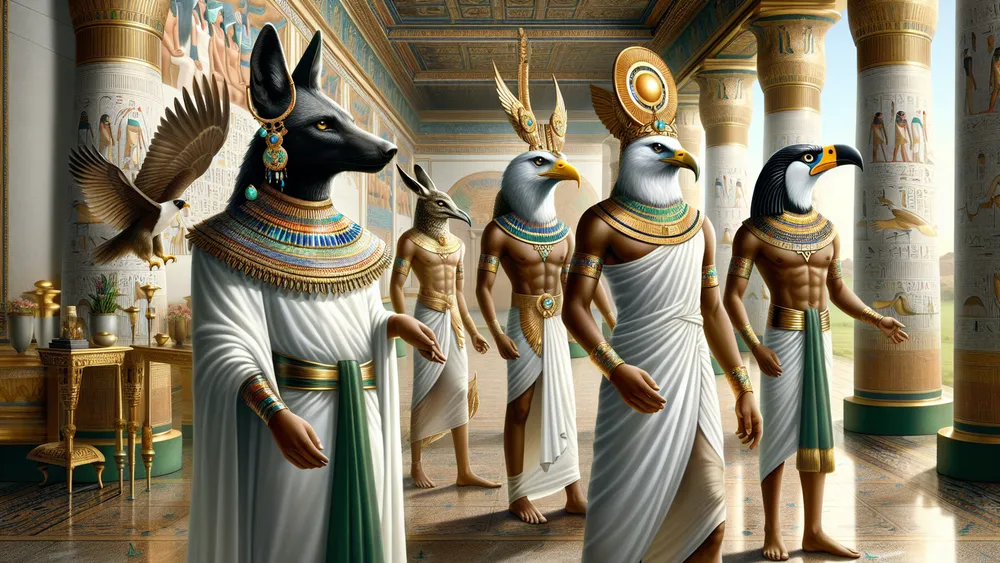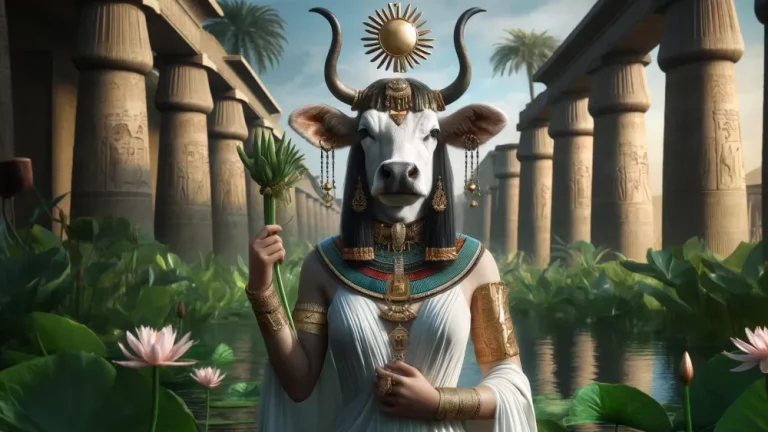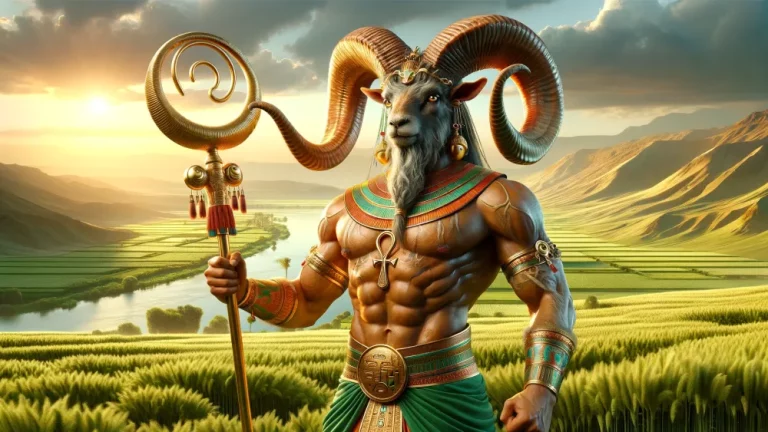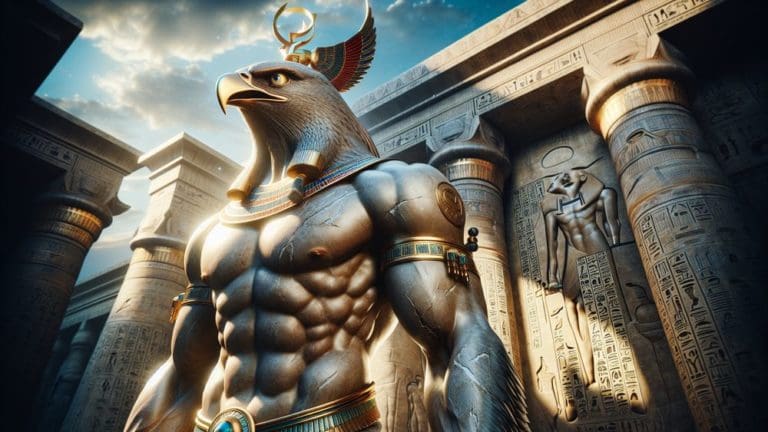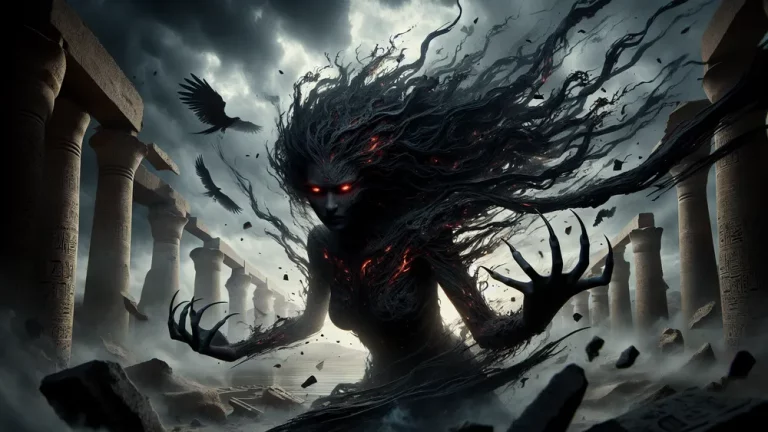Why Did Egyptian Gods Have Animal Heads?
History Behind Egyptian Gods with Animal Heads
One must look into the beginnings and changes of animal-headed gods in ancient Egypt, to see their historical situation and how they changed over time.
Key Points:
- Animal-headed gods originated from early animal worship and totemism.
- Egyptian gods had animal heads to symbolize specific powers and traits.
- Animal-headed gods played a crucial role in ancient Egyptian religion and daily life.
- Different animal heads represented different meanings and attributes of the gods.
- The appearance of animal-headed gods evolved over time due to changes in art styles, beliefs, and historical events.
- Modern interest in Egyptian animal-headed gods persists in art, literature, and media.
Where Did Animal-Headed Gods in Egypt Come From?
The early showings of gods with animal heads in old Egyptian art and stories can be seen going back to the Predynastic Period, around 4000-3100 BCE. Carvings, pottery, and early hieroglyphs often showed gods with heads of animals such as falcons, jackals, and lions. These images were not just art choices but very symbolic, showing the traits and powers tied to each animal.
The falcon-headed god Horus was like this to show his control over the sky and his job as a protector of the pharaoh. As well, the making of these gods was greatly shaped by old animal worship. Early people often respected animals, thinking they had spiritual meaning and power. This respect is clear in the totemistic acts of old groups, where animals were seen as ancestors or protectors.
These thoughts became part of the religious beliefs of ancient Egypt, making gods with animal heads.
Some of the earliest known animal-headed gods include:
- Horus (Falcon-headed): God of the sky, kingship, and protection.
- Anubis (Jackal-headed): God of mummification and the afterlife.
- Sekhmet (Lioness-headed): Goddess of war and healing.
- Thoth (Ibis-headed): God of wisdom, writing, and knowledge.
These gods were crucial in the religious and cultural life of old Egyptians, having the traits and powers of the animals.
Gods with animal heads in ancient Egyptian art were symbolic representations of traits and powers tied to each animal, reflecting early beliefs in animal worship and the spiritual significance attributed to animals.
How Animal-Headed Gods Changed Over Time
The way animal-headed gods were shown in old Egypt changed a lot from the Old Kingdom to the New Kingdom. In the Old Kingdom, pictures of these gods were usually stiff and strict, showing the very structured society. Gods were usually shown in a still, straight-on pose to stress their never-changing, forever nature.
Moreover, in the Middle Kingdom and even more in the New Kingdom, the art styles became more lively and true to life. Gods were shown in more real and active poses, showing a shift toward a closer bond between gods and people.
This change in art can be related to how today’s art has moved from old, strict styles to more free and lively forms. Also, some big historical events played a part in these changes in art styles and beliefs.
The joining of Upper and Lower Egypt around 3100 BCE brought together different local gods and ways of worship, leading to a more mixed and complex group of gods. The Hyksos invasion during the Second Intermediate Period brought in new culture and beliefs, which were then added to Egyptian stories about gods.
The Amarna Period, under the rule of Akhenaten, saw a big shift to believing in one god, the Aten, which for a while changed the usual way gods were shown. After Akhenaten’s time, people went back to believing in many gods, but with a new focus on the close and reachable nature of the gods.
These important events played a big role in changing how animal-headed gods were shown in old Egyptian art and religion.
What Animal Heads Meant in Egyptian Myths
To really understand the meaning of animal-headed gods, it is important to look at the symbol meanings behind these animal heads in Egyptian stories.
How Animal Heads Showed Gods’ Powers and Traits
In old Egyptian stories, the animal heads of gods were not random but chosen to show specific powers and traits. Additionally, the falcon head of Horus showed his rule over the sky and his role as a protector of the pharaoh. The falcon, with its keen eyesight and swift flight, was a good symbol for a god who is linked to vision and safety.
Jackal head of Anubis, this showed his tie to the afterlife and mummification. However, jackals were often seen near cemeteries, their scavenging behavior was seen as a way of watching over the dead, making the jackal a fitting symbol for a god watching over the journey to the afterlife.
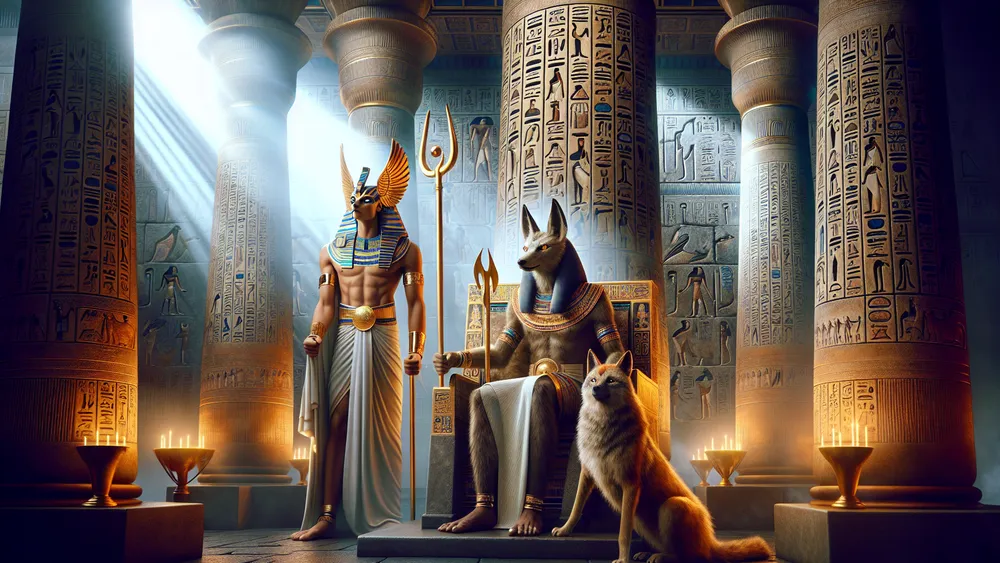
Furthermore, to make these symbol meanings clearer, here is a list of common animal heads and what they stood for:
- Falcon (Horus): Vision, protection, kingship.
- Jackal (Anubis): guidance, protection in the afterlife, mummification.
- Lioness (Sekhmet): Strength, war, healing.
- Ibis (Thoth): Wisdom, writing, knowledge.
- Cow (Hathor): Motherhood, fertility, love.
- Crocodile (Sobek): Power, fertility, protection.
These animal heads were deeply in the culture and religion of old Egypt, not just art choices. They offered a visual shortcut for the gods’ powers and roles, making it simpler for people to understand and relate to their gods.
The Lion Head: Meaning and Gods Connected to It
In Egyptian stories, the lion head was a strong symbol for strength, bravery, and safety. Additionally, lions were highly respected in old Egypt because of their skills and leading role in the animal world, much like how they are seen as symbols of power and courage in different cultures now.
Lions’ fierce nature and protecting instincts made them ideal to show gods linked with war, healing, and guarding. This symbol can be clearly seen in the lion-headed goddess Sekhmet, who was known as the goddess of war and healing. Sekhmet’s lion head meant her fierce and protective nature. Moreover, her ability to bring both destruction and healing.
However, another god linked to the lion head is Bastet, who initially shared many traits with Sekhmet but later became a calmer goddess of home, fertility, and childbirth. Bastet’s lioness form meant her protective role over households and her caring traits.
The lion head in these gods showed the dual nature of strength and protection, showing how the same symbol could mean both fierceness in battle and safety at home. This duality made the lion head a flexible and strong symbol in the group of Egyptian gods.
The Jackal Head: Ties to the Afterlife and Gods
In Egyptian stories, the jackal head is very much tied to the afterlife, meaning guidance and safety for the dead. Jackals are often seen near graveyards, which scavenge around burial places, leading the old Egyptians to link them with death and the afterlife. This link is shown best in the god Anubis, who has the head of a jackal.
Moreover, Anubis was the god of preserving bodies and the afterlife, responsible for guiding souls through the underworld and making sure they go through safely. His jackal head meant his role as a watcher of the dead, much like a guide who helps people through unknown and hard areas.
Anubis’s role was more than just watching over; he was also part of the crucial process of preserving bodies, which was needed for the dead to go into the afterlife. The jackal head of Anubis showed not only his protective side but also his ability to guide souls through the complex journey of the afterlife.
This advice was important for making sure that the dead could reach the afterlife safely and be judged in a good way. The symbol meanings of the jackal head – guidance and safety – were key to Anubis’s identity and his important role in Egyptian funerary ways.
This made the jackal head a strong symbol of the afterlife and the godly protection that waited for the dead.
The Falcon Head: Links to the Sky and Royalty
In Egyptian stories, the falcon head is a strong symbol of the sky, vision, and kings. Falcons, known for their fast speed and sharp eyes, were seen as great birds that flew high above the ground, showing a link between the stars and the earth. More importantly, this symbol is clearly shown in the god Horus, who often has the head of a falcon.
Horus, the god of the sky and kings, had his falcon head to show his control over the sky and his part as a protector of the pharaoh. Much like how eagles are respected in many cultures now for their power and vision, the falcon was a good symbol for a god linked with divine rule and protection.
Furthermore, another god linked with the falcon head is Ra, the sun god, often shown as a falcon or a man with a falcon head. Ra’s falcon head stood for his journey across the sky, bringing light and life to the world. The falcon’s ability to fly high and its keen vision made it a good sign of Ra’s all-seeing nature and his part as a life-giver.
Likewise, the symbol meanings of the falcon head – kingship and divine protection – were key to both Horus and Ra, showing their roles as top gods who controlled the sky and watched over the living world. This made the falcon head a strong symbol of control, vision, and divine care in old Egyptian stories.
The falcon head symbol in Egyptian mythology represents power, vision, and divine protection, crucial for gods like Horus and Ra who were seen as top deities controlling the sky and safeguard the world.
The Ibis Head: Wisdom, Smarts, and Godly Duties
In Egyptian tales, the ibis head is a strong symbol of wisdom, smarts, and talking. Moreover, the ibis, a bird with a long, curved beak and a graceful look, was linked to smart work and school stuff. This meaning is mainly shown in the god Thoth, who has the head of an ibis. Thoth was the god who knew stuff, wrote things, and had knowledge.
Plus, the ibis head meant he was the divine writer and keeper of all knowledge. Much like how modern smart people or writers are respected for their brain and clear talk, Thoth’s ibis head showed his control over language and his part in keeping things in order through his knowledge.
However, Thoth did more than just keep track of stuff; he also made hieroglyphs and measured time, making him important in handling both godly and people things. The ibis head of Thoth showed not only his smart nature but also his power to link the godly and human worlds through talking and knowledge.
Therefore, the symbol meanings of the ibis head – wisdom and talking – were key to Thoth’s identity and his big part in Egyptian tales. This made the ibis head a strong symbol of smart control and the godly jobs tied to keeping order and knowledge in the world.
Other Animal Heads and What They Stand For in Egyptian Gods
Besides the well-known gods with animal heads, Egyptian tales have many other animal heads that stand for different traits and powers. For example, the crocodile head is linked to the god Sobek, who was respected for his strength and guard qualities. Sobek’s crocodile head showed his fierce nature and job as a guardian of the Nile, much like crocodiles in the wild are seen as strong and tough creatures.
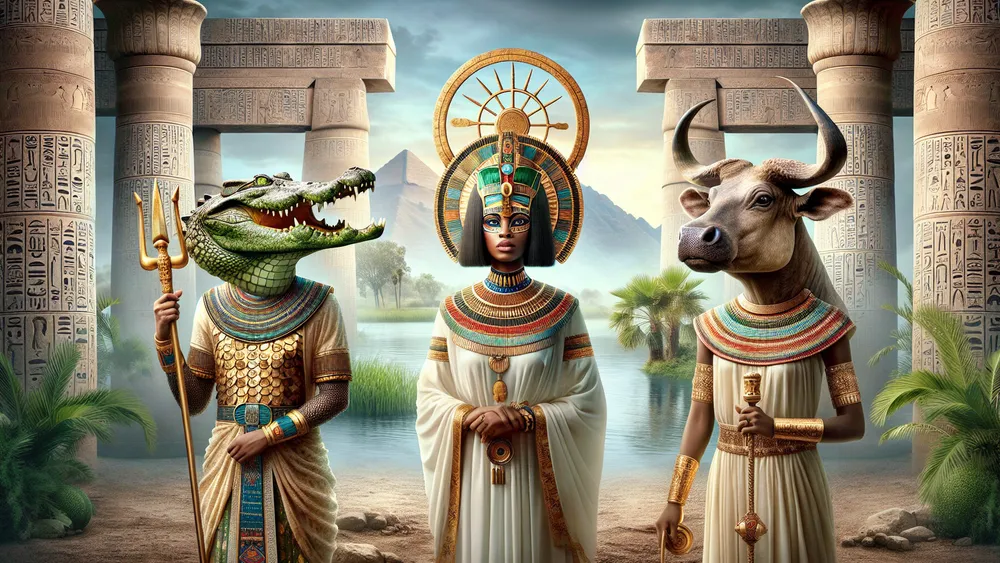
Another example is the cow head, linked to the goddess Hathor. More importantly, Hathor’s cow head meant fertility, motherhood, and nurturing, which reflects the cow’s part as a giver of food and care in farming societies. Furthermore, the hippopotamus head is another important sign in Egyptian tales, linked to the goddess Taweret. Taweret’s hippopotamus head means protection for pregnant women and kids.
The hippopotamus, which is known for its strong presence and guard instincts, made it a good sign for a goddess whose duty is looking after mothers and their children. These animal heads and their linked gods show the rich mix of signs in Egyptian tales, where each animal’s traits are chosen carefully to mean certain divine traits and roles.
| Animal Head | Symbolism | Associated Deity |
|---|---|---|
| Crocodile | Strength, Protection | Sobek |
| Cow | Fertility, Motherhood | Hathor |
| Hippopotamus | Protection, Motherhood | Taweret |
This table sums up the animal heads, what they mean, and the gods they are linked with, giving a clear and simple look at the different and detailed signs in Egyptian tales.
Cultural Importance of Animal-Headed Gods in Ancient Egypt
Knowing the symbolic meanings of these animal-headed gods, it gives you a look into their deep cultural importance in old Egyptian society.
Worship and Respect for Animal-Headed Gods
In ancient Egypt, animal-headed gods were deeply respected and received a lot of devotion. These gods were seen as strong protectors and helpers, showing the godly traits of the animals they stood for. The Egyptians thought that by respecting these gods, they could get favor and protection in their everyday lives.
Temples for animal-headed gods were worship centers where priests did big rituals to honor the gods. These rituals had offerings of food, drinks, and valuable things, kind of like how people today might leave flowers or light candles at a shrine to show respect and ask for blessings. Moreover, rituals and events for animal-headed gods were important to Egyptian religious practices.
For example, the Festival of Opet was a big event where statues of gods like Amon-Ra, who was often shown with a ram’s head, were paraded through the streets to ensure land fertility and the prosperity of people. Daily life in ancient Egypt was strongly connected with worshiping these gods. People would pray to certain gods for help, protection, and success in different life aspects, from farming to having babies.
Having animal-headed gods in homes, temples, and public places showed their importance in keeping the balance and harmony of the world, which reflected the Egyptians’ belief that the divine and mortal worlds were connected.
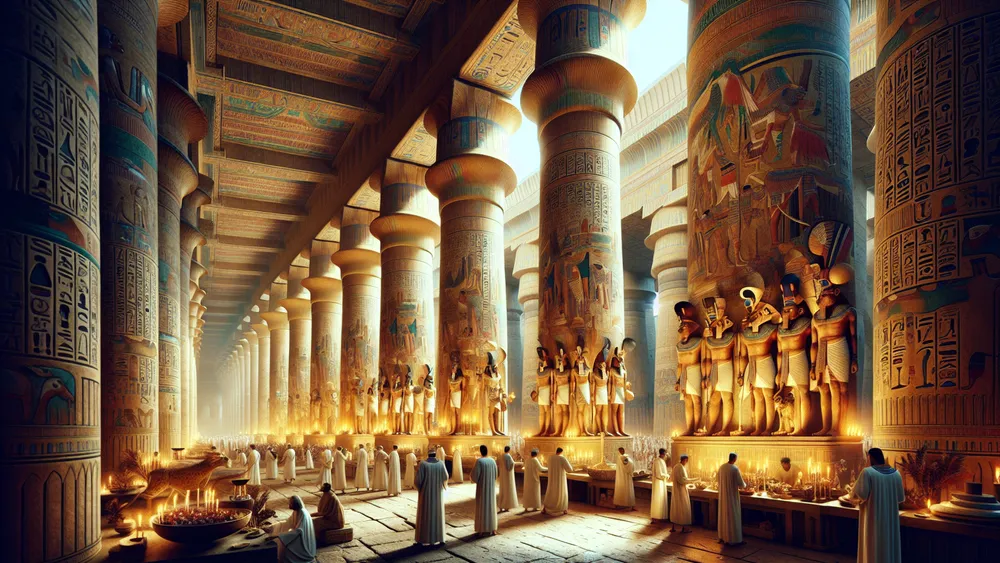
Temples and Traditions for Animal-Headed Deities
Temples which are for animal-headed gods were among the most important and highly respected buildings in ancient Egypt. These special places were not only for worship but also centers of community life and religious activity. Additionally, the size and scale of these temples showed the importance of the gods they honored.
For example, the Temple of Horus at Edfu, which is for the falcon-headed god Horus, is one of the best-preserved temples in Egypt. Its big pylons, detailed carvings, and large courtyards were made to create awe and respect among worshippers, much like modern-day cathedrals or mosques are used as central places of worship and community meeting.
The architectural features of these temples were carefully planned to fit with religious beliefs and practices. Temples often had big hypostyle halls, sanctuaries, and sacred lakes, where many rituals and ceremonies happened. Priests did daily offerings, cleanliness rites, and festivals to honor the gods and ensure their favor.
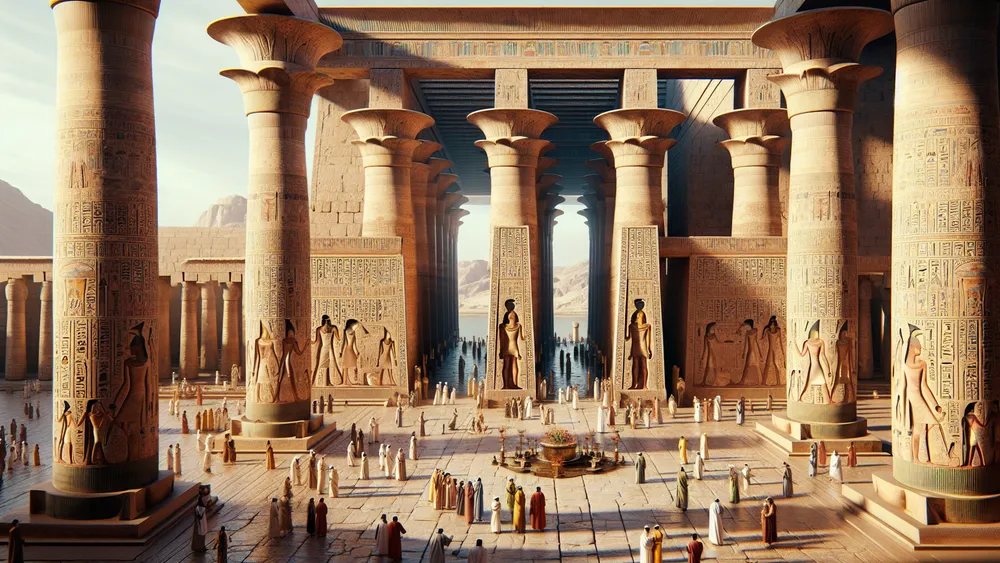
For instance, the Temple of Horus at Edfu held the yearly Festival of Victory, which celebrated Horus’s win over Set. Therefore, these religious practices were crucial for keeping the divine order and balance in the world, showing the close connection between the physical structures of the temples and the spiritual lives of the ancient Egyptians.
Lasting Impact and Modern Interest in Egyptian Animal-Headed Gods
The impact of animal-headed gods from ancient Egypt still affects modern culture and media. These gods, with their unique and strong imagery, have grabbed the imagination of people everywhere. From movies and TV shows to video games and comic books, Egyptian gods like Anubis, Horus, and Bastet often appear as characters, which often show their well-known animal heads.
Therefore, this interest can be compared to the present-day interest in superheroes, who also have special powers and traits that make them unique. The ongoing appeal of these gods lies in their rich symbols and the ageless themes they stand for, such as protection, wisdom, and justice. Additionally, modern art, writing, and popular culture keep using these old gods.
Artists make great pictures of gods like Thoth with his ibis head, while writers tell detailed stories that include the myths and legends of Egyptian gods. For instance, Rick Riordan’s “The Kane Chronicles” series shows young readers Egyptian myths through a modern-day view. There is ongoing research and interest in Egyptian myths by scholars and fans too, which ensures that new findings and ideas keep coming up.
Archaeological digs, academic studies, and museum shows all help us know more about these interesting gods, thus keeping their impact alive and important in today’s times.
FAQs
1. Why did ancient Egyptians depict their gods with animal heads?
Ancient Egyptians depicted their gods with animal heads to symbolize specific powers, attributes, and cultural beliefs associated with those animals.
2. Which Egyptian god has a falcon head?
The Egyptian god with a falcon head is Horus, who symbolizes kingship and divine protection.
3. What is the significance of the jackal head in Egyptian mythology?
The significance of the jackal head in Egyptian mythology lies in its association with Anubis, the god of mummification and the afterlife, symbolizing guidance and protection in the afterlife.
4. Are there any modern interpretations of Egyptian animal-headed gods?
Modern interpretations of Egyptian animal-headed gods often appear in contemporary art, literature, and media, reflecting their enduring cultural impact.

